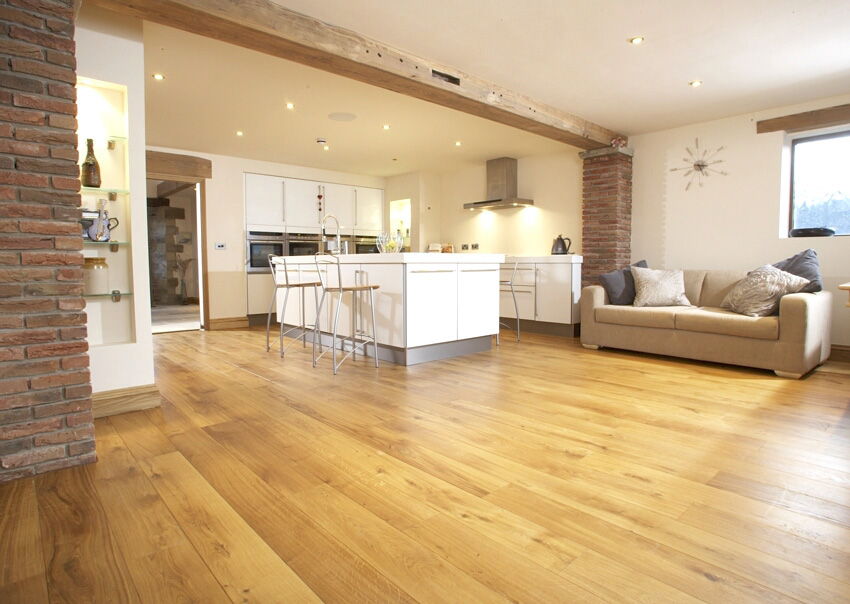Solid Wood Flooring - A Quick Guide
Solid hardwoods are arguably the first choice amongst discerning householders for flooring. Combining a timeless elegance with durability, ease of maintenance and cleaning, there is nothing that quite compares with the beauty of a real wood floor.

There are many misconceptions about wood. These misconceptions lead to fears about how it reacts under different conditions and how suitable it is for flooring. Although most of these fears are unfounded they are seized upon and exaggerated by companies selling inferior and imitation products.
At British Hardwoods we have years of experience in sourcing timber and the manufacture of solid wood flooring. A combination of this depth of knowledge and the very best in production practices means that we can offer an unparalleled range of products and service.
Wood – How it reacts
Contrary to what a lot of people believe, temperature is not the main factor that determines how wood behaves, rather it is moisture that is the main cause of movement. The two environmental factors are linked, in that the warmer the air the more moisture it can hold. Wood is a hydroscopic material and as such it will always try to reach equilibrium with its surrounding environmental conditions. So, in the winter when the climate is cold and central heating systems are on full, the atmosphere can be very dry causing wood to shrink. Conversely, in the summer the air is warm and therefore susceptible to holding more moisture, which will cause wood to swell.
Why does wood move?
In its growing state wood is full of water. The water is held within the tree in two forms, namely free water and bound water. Free water is held in the timber’s cells and bound water is held in the cell walls. Once felled timber will lose its free water quite quickly without any resultant deformation. However, as the timber is kiln dried to make it suitable for internal applications it starts to lose its bound moisture which causes the cells, and consequently the whole piece of timber, to shrink. As this happens the timber also gets harder.
How does wood move?
Although wood will shrink as explained above the amount of shrinkage is not the same in all directions. The majority of shrinkage takes place tangentially, i.e. in the direction of the annular growth rings. Radial shrinkage is about half that of tangential shrinkage whilst shrinkage in the length is virtually non existent. The results of shrinkage too are different. Radial shrinkage will lead to a decrease in width across the board whereas tangential shrinkage is more likely to lead to cupping. If you consider that, in effect, a shortening of the annular rings takes place, then the likely results of shrinkage can be predicted. Most floorboards are tangentially cut.
Fitting a solid wood floor
When fitting a solid wood floor, allowance needs to made for the natural seasonal occurrence of expansion and contraction. An expansion gap of at least 12mm should be left around the entire perimeter of the floor. The expansion gap can then be covered by replacing skirting boards or by a matching wood-floor beading. An expansion gap should also be left in the doorway, covered by an appropriate threshold piece.
We would not, however, recommend the use of the solid wood flooring in conjunction with under-floor heating. Engineered Wood Flooring is more suitable in that application. We would always recommend seeking professional advice prior to any home improvement project. Our friendly team can offer expert guidance on fitting our solid and our engineered hardwood floors.
Solid wood flooring from British Hardwoods
At British Hardwoods we do not fill our warehouse with hundreds of uniform packs of flooring. All the raw timber is checked on delivery to ensure the quality is correct and, most importantly, the moisture content is right. We specify 8 – 10%, ideal for the normal UK centrally heated home. Each board is then machined twice to ensure the very best finish and the finest tolerances. Our Weinig moulders are universally considered the ‘Rolls Royce’ of the woodworking industry and are accurate to +/- 0.1mm.
All boards are then inspected, trimmed to length and defected using a computer controlled optimising saw. All boards are ‘end matched’, a process which continues the tongue and groove around all four sides of each board, ensuring the tightest possible fit at installation. Boards are then re-checked for dimensional accuracy and moisture content before being wrapped in protective packaging prior to despatch.
We manufacture each floor specifically to order, so that when you buy from us you can be sure of the best possible individual service. We can not only tell you exactly how many metres you have received and the exact moisture content of the wood, but also on what day and time it was manufactured and who made it! All vital points in our stringent quality circle.
To view our range of solid wood flooring click here >>
For further advice on fitting and finishing your wood flooring call us on 01535 637755 or follow the link to download our free Hardwood Floor Fitting and Maintenance Guide.

